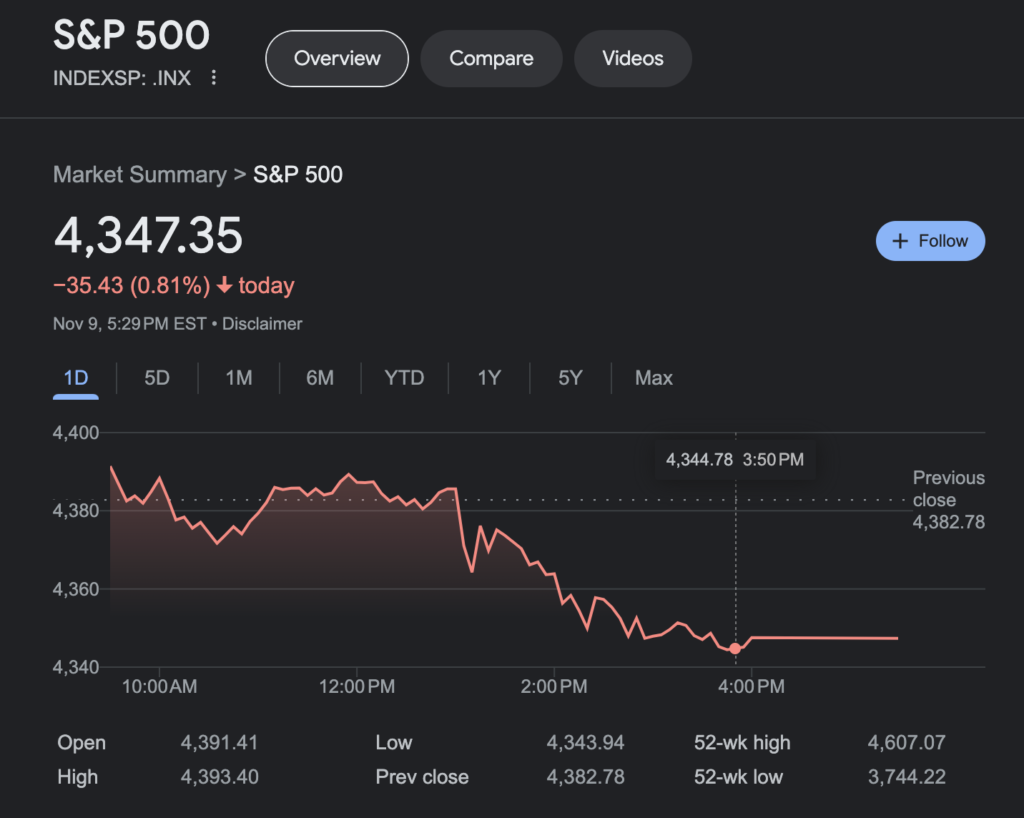Choppy Waters Ahead: U.S. Stock Futures Wrestle with Prolonged Rate Pressures
U.S. stock futures encountered obstacles on Friday because of a disappointing bond auction and recent signals suggesting that interest rates might stay high for a long time. As a result, the promising performance of major stock indexes came to a temporary halt.
How stock-index futures are trading
- The value of the S&P 500 futures decreased slightly by 1.5 points to reach 4,360.75.
- The futures for the Dow Jones Industrial Average, represented by YM00, went up by 29 points and reached a value of 33,974, indicating a 0.28% increase.
- The value of the Nasdaq-100 futures, called NQ00, dropped by 38.75 points and is currently at 15,217.75.

On Thursday, the Dow industrials, S&P 500, and Nasdaq Composite all saw decreases. The Dow closed at 33,891.94 after dropping 220.33 points or 0.7%, while the S&P 500 closed at 4,347.35 after falling by 35.43 points or 0.8%. The Nasdaq Composite had the biggest decrease, closing at 13,521.45 after dropping 128.97 points or 0.9%.
Market drivers
The S&P 500 and Nasdaq Composite’s longest winning streaks since November 2021 were halted on Thursday due to a poorly received $24 billion sale of 30-year Treasury bonds.
Bond yields saw a small decline on Friday. The yield on the 30-year Treasury note, identified as BX:TMUBMUSD30Y, dropped by 2 basis points to 4.739%, in contrast to Thursday’s rate of 4.777%. Thursday’s surge in yield was nearly the biggest one-day rise since June 2022.
The potential influence that a ransomware attack on the U.S. branch of the Industrial & Commercial Bank of China had on the Treasury market in the United States was unclear in terms of how it would affect the Treasury auction.
Investors were reviewing the recent increase in the stock market, which was influenced by the anticipation of the Federal Reserve ending its interest rate hikes. This shift in sentiment came after Federal Reserve Chairman Jerome Powell cautioned against being swayed by short-term inflation changes and mentioned that achieving the desired 2% goal was not certain.
Pierre Veyret, who is a technical analyst at ActivTrades, said that the sudden change to a more assertive position goes against the earlier recommended cautious approach that was talked about in the previous FOMC meeting. As a consequence, investors are unsure and do not have a clear understanding of where monetary policies are heading in the future.
Investors are advised to not make investment decisions based on gossip and wording, but rather wait for clear instructions and actions from central banks. As a result, stock markets might become more stable with less uncertainty, as investors delay making significant changes to their risky investments until the release of next week’s consumer price data in the US, European Union, and UK.
The United States will release the consumer price data for November to the public next Tuesday.
Investors will closely monitor the remarks of different members from the Federal Reserve on Friday. Lorie Logan, the President of the Dallas Fed, is set to speak at 7:30 a.m., followed by Raphael Bostic, the President of the Atlanta Fed, at 9 a.m., and Mary Daly, the President of the San Francisco Fed, at 1 p.m. In addition, the University of Michigan will announce its preliminary consumer sentiment survey for November at 10 a.m. in Eastern time.




